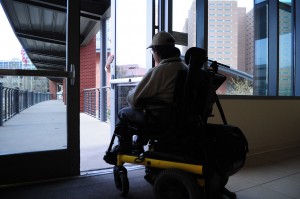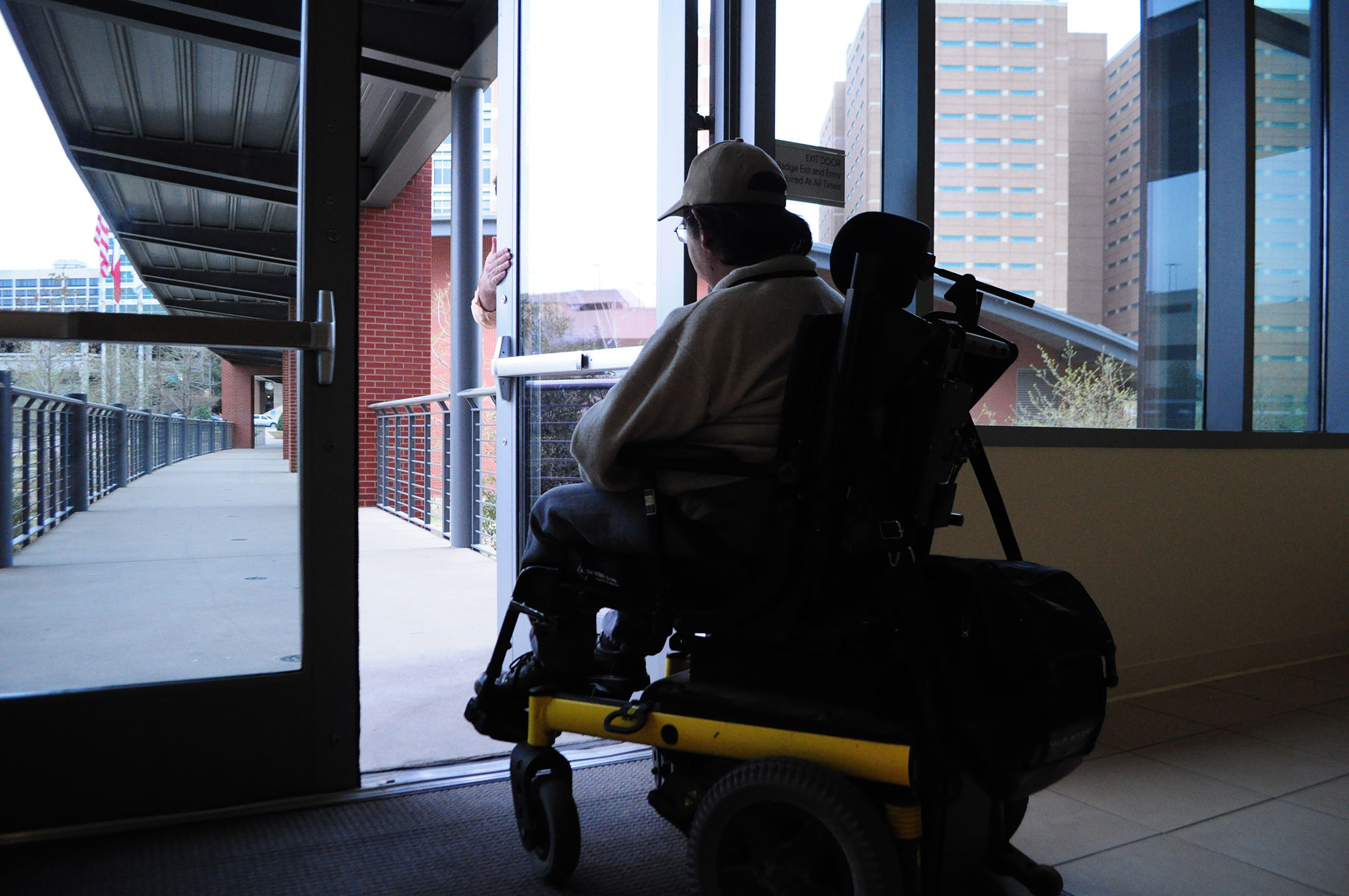
By Kirsten Mahon/tr news edtitor
TR student Tim Nieto has muscular dystrophy and must use a motorized wheelchair to get around the campus. To him and many other disabled students, every door, elevator and walkway is an efficient pathway or a troublesome blockade.
Nieto said he’s late to class constantly, if only by a few minutes, because he has to ride the elevator, which is crowded with determined students during peak hours. When attending classes in the East Fork, he must ride up to the top floor before he can come back down to the floor where his class is. Only TRTR has elevators dedicated to disabled users.
Because TR Campus has seven floors of classrooms and utilities, the layout is unique compared to the other four campuses and different accommodations must be made accordingly for disabled students. The campus was built as an office space originally, but no major changes were necessary when the campus opened in 2009, Debbie Schall said.
TR student Conner Moyer feels strongly about helping his fellow disabled classmates. Currently, Moyer is pushing to provide disabled students with a reliable transportation method and a handicap-only elevator, especially during peak hours, he said.
“When you go to big colleges, sometimes they lock the door after class has started,” Moyer said. “What if these students are late and miss a test?”
Moyer said the elevators should also be equipped with a voice that lets blind students know which floor they are on as well, but voiced elevators currently exist only on TRE Campus.
Disabled student services and building services work together to make sure the correct facilities are changed to give every student an equal chance at their education, said Ivette Buehler, student development associate. For deaf students, the school provides interpreters and a court reporter who will type up lectures during the class period. She said it is up to building services to provide physical amenities like talking elevators for blind students and ramps for wheelchairs.
During previous semesters on campuses other than TR, Nieto said advisors have directed him toward instructors and classrooms they know will be either more accessible or more accommodating than others. When academic buildings are sprawled across a landscaped campus, Nieto said traveling to and from class can be exhausting. Taking classes in buildings with elevators rather than grass and walkways was intended to be beneficial.
Doors provide another issue for Nieto. Some entrances on TR Campus aren’t equipped with automatic doors. Nieto likes to enter the building on the third floor of the East Fork because it’s the closest entrance to the bus stop, but sometimes he has to wait until someone can open the door for him.
The Americans with Disabilities Act requires appropriate accommodations in all public facilities for the disabled, barring those built prior to the act. The act does not demand that every entrance and restroom in a public facility be equipped with automatic doors so long as there are easily accessible entrances and restrooms with these accommodations available on the grounds.
“We meet all the standards, and we go above and beyond for students,” Schall said.
Moyer said he has suggested allowing disabled students to use the freight elevators to DSS and the administration. The freight elevator in the East Fork has large doors that would be accessible for wheelchairs but currently has a sign that states use by only faculty and staff. Instructors and non-maintenance staff frequently use the elevator, he said, but it is not nearly as crowded as the public elevators. This would solve issues for a student like Nieto.
“We’ve had meetings with the president to find ways to alleviate the situation,” Schall said. “We are currently looking into getting a campaign started.”
The campaign would encourage better etiquette among the population on TR Campus that would let students like Nieto use the elevator first so they have ample time to get to class on time like every other student. Schall said he would hope students would do the right thing when they see disabled students using the elevators.
“The right thing to do is to take the flight of stairs and let the disabled student use the elevator,” she said. “I think it’s a part of the etiquette of being a good citizen.”
DSS works to help provide students with equal opportunities by working with student schedules to take care of their individual needs. When suggestions or complaints are made, Buehler said DSS normally fixes the problem if it can. Currently, TR Campus is set to have more restrooms easily accessible for students in wheelchairs. As of yet, there is no budge on officially allowing anyone other than faculty and staff to use the freight elevators.
“The TR Campus hallmark of an unshakeable focus on student learning will meet its mark by ensuring disabled students get to class on time,” Moyer said.

